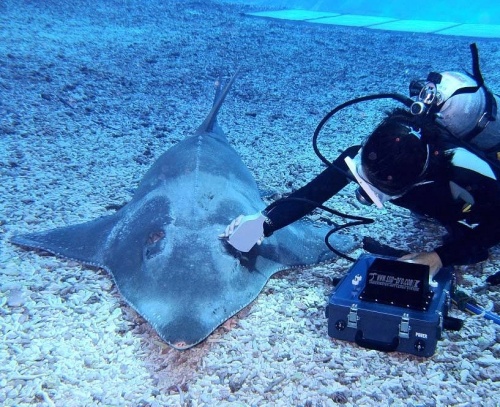Churashima Foundation discovers eye protective function for rays

A staff member using an echoing survey method on a giant guitarfish (Photograph provided by Okinawa Churashima Foundation.)
December 9, 2015 Ryukyu Shimpo
A group of researchers from the Okinawa Churashima Foundation in Motobu Town achieved the world’s first discovery of a ray species’ protective function for its eyes. The research group announced the result by December 8. The species studied buries its body under the sea bed and, according to the group, uses a particular eye muscle to bury its eyes deeper than other species do in order to protect them.
A representative researcher, Taketeru Tomita, shared the group’s research results as “It’s not common for the species to have eyelids, if you look at the whole species. From the result, we can see how there are various ways to protect eyes.”
Many ray species live on the surface of the sea bed, and usually they leave their eyes uncovered by the sand while they bury their bodies. The researched ray does not have eyelids to close, and so buries its eyes in a pocket located around the center of its head.
The research was conducted using giant guitarfish (Rhynchobatus djiddensis) as a sample. After measuring the species’ eye motion using ultrasonic diagnostic equipment, the result showed that the ray is able to bury the whole of its eyes into the pocket and the movement distance of the eyes is the largest among vertebrate animals. The research group further used dead specimens to add electronic stimuli to one of the eye muscles, the inferior oblique muscle, which enables the species to bury its eyes.
The results will be published in the international scholarly journal “Zoology”.
(English translation by T&CT and Sayaka Sakuma)
Previous Article:Kiyuna wins fourth straight victory at Japan Cup Karatedo
Next Article:Photographers discuss significance of Koza riot
[Similar Articles]
- World’s First Technique to Identify Fish Species from a Bucket of Water
- Ryukyu Immunology Corporation develops test kits to detect HIV infection
- OIST scientist proposes new theory on limited migration of coral reefs in Okinawa
- GPS shows sea turtle drifted from Saipan to Kunigami
- Do corals form clouds? University of Tokyo and OIST researchers decode Acropora genome, hope to elucidate environmental adaptability
 Webcam(Kokusai Street)
Webcam(Kokusai Street)


